Abstract
Vegetable production in Canada varies from year to year depending on climatic conditions and advances in agricultural technology. According to the latest data for 2022, lentils recorded the largest yield at 2.3Mt, with Saskatchewan being the major producing area. Production of this legume has been stable in recent years and it is one of the important pillars of Canadian agriculture. On the other hand, when looking at the production volume of tomatoes by use, a high proportion is consumed mainly for processing, and they play an important role as an ingredient in ketchup and sauces. Regarding land use, tomato cultivation is progressing especially in warm regions, and large-scale agriculture making use of vast tracts of land is a characteristic of the region. In terms of production volume and land use by vegetable, while Canada is known for its thriving cultivation that takes advantage of its cool climate, there is also an increasing demand for tomatoes, lentils and other vegetables that take advantage of the warm climate, and a wide variety of production is carried out according to variety and purpose.
Production (by vegetables)
Significant trends in Canadian vegetable production are evident, particularly in lentil production. Looking back at data from 1961 to 2022, lentil production peaked at 3.19 Mt in 2016, making it an important part of Canadian agriculture. However, production volume has declined in recent years and currently stands at just 72% of its peak level. This decline is thought to be due to fluctuations in global supply and demand, market trends, and changing climatic conditions. While lentils are trending downward, other crop production has remained stable, particularly for beans and other cool season crops, across Canada. Lentils are primarily grown in Saskatchewan, and one of the factors affecting them is thought to be a decrease in demand from export destinations. Additionally, advances in agricultural technology in Canada are driving a shift to new and more profitable crops, resulting in a more diversified crop mix. In light of these changes, Canadian vegetable production is adapting to changing supply and demand trends and the market, while selecting crops that are in line with the times.
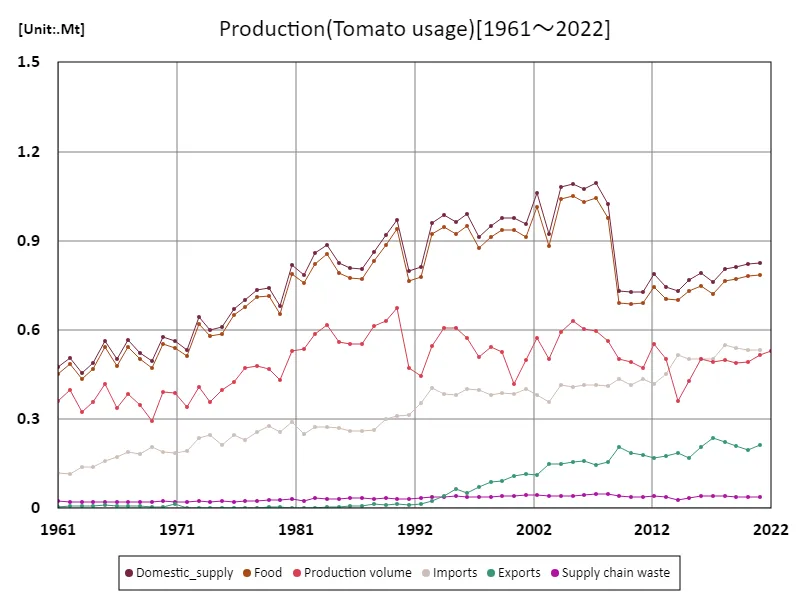

The maximum is 1.09Mt[2007] of Domestic_supply, and the current value is about 75.6%
Yield(by vegetable)
In Canada’s vegetable production, tomato yields have grown significantly, reaching a record level of 85.9t/ha in 2022. This figure is the highest in data from 1961 to 2022, indicating the growing importance of tomato production. Tomato production is steadily increasing due to intensive cultivation, especially in warmer regions, and the demand for tomatoes for processing in particular is high. Tomato yields are still at 100% of their peak level, proving that recent improvements in agricultural technology and the introduction of improved varieties have been successful. In particular, the introduction of precision agriculture techniques and advances in irrigation technology have made it possible to achieve high yields more efficiently, which is thought to have led to an increase in harvest volume. In addition, the use of vast farmland that takes advantage of the warm climate conditions supports the expansion of tomato production. In addition to serving the domestic market, Canada is also focusing on export markets, particularly the increased supply of tomatoes for processing to the United States and other countries. This has made tomato production a stable source of revenue for Canadian agriculture and it is set to continue to be an important crop in the future.
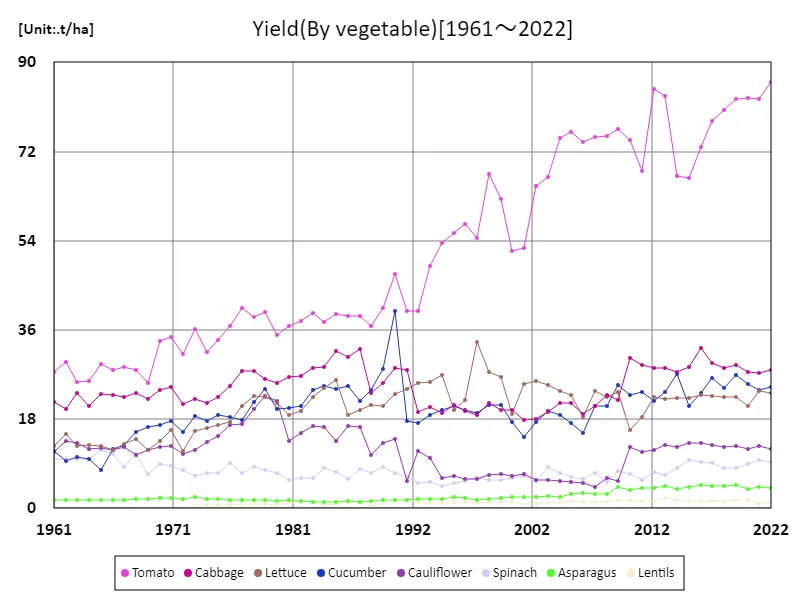

The maximum is the latest one, 85.9t/ha of Tomato
Land use (by vegetables)
Data on land use for vegetable production in Canada in 2022 highlights the proportion of lentils in the total. Lentils cover an area of 1.72 mha, making them the largest agricultural land use in Canada. This scale indicates that lentils are an important crop in Canadian agriculture, especially in cooler regions where they are grown on a large scale, such as Saskatchewan. Lentils enjoy stable international demand and are also in strong demand as an export crop. Meanwhile, the total area of agricultural land in Canada is 1.74mha, with the average land use being 218kha. The data show that crops, particularly lentils, are grown extensively in Canadian agriculture, while other crops account for relatively small land uses. In particular, crops suitable for cool climates and legumes are cultivated predominantly, and land use that takes advantage of the climatic conditions suitable for each crop is carried out. Going forward, Canadian agriculture will need to continue to select crops and optimize land use in response to climate change and market demand, and production of staple crops such as lentils is expected to continue to play an important role.
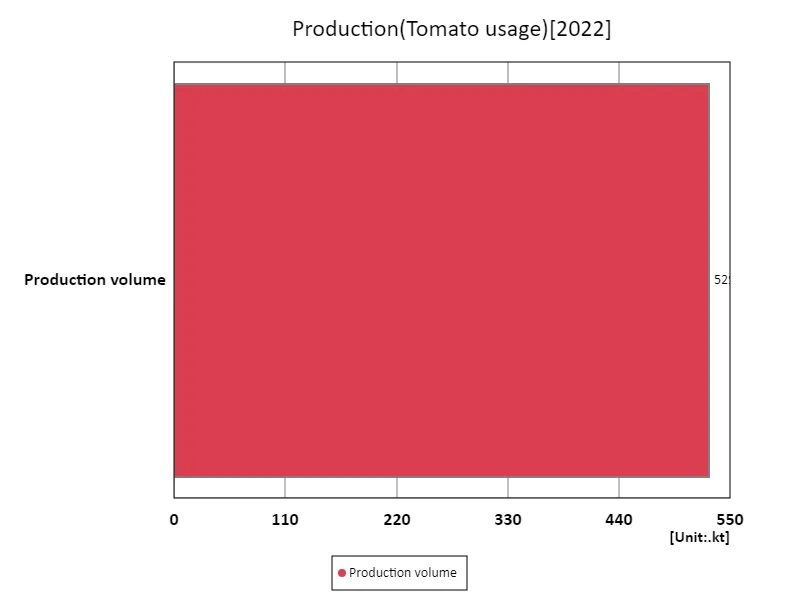

The maximum is 529kt of Production volume, the average is 529kt, and the total is 529kt
Tomato usage
Data on tomato production by use in Canada shows that domestic supply peaked in 1961 at 1.09 Mt, a level that remains at its peak today. During this period, Canadian tomato production was primarily focused on supplying the domestic market, with domestic consumption and the fresh market dominating. However, as time went on, the uses of tomatoes became more diverse, and the demand for tomatoes for processing in particular soared. Processing tomatoes are widely used in the manufacture of food products such as ketchup, tomato sauce and canned goods and have come to occupy an important role in Canadian tomato production. This has led to Canadian tomato production becoming more dependent not only on the domestic market but also on export markets, particularly the US market. As the scale of tomato production expands, large-scale agriculture that takes advantage of the warm climate has progressed, and tomato production volume has remained stable at a high level. In addition, technological innovation and improved varieties have led to increased yields and improved production efficiency, strengthening production systems to accommodate the specific uses of tomatoes. Since 1961, when domestic supply reached its peak, we can see a trend towards a more commercial and diversified production, coupled with an increasing demand for processing tomatoes.
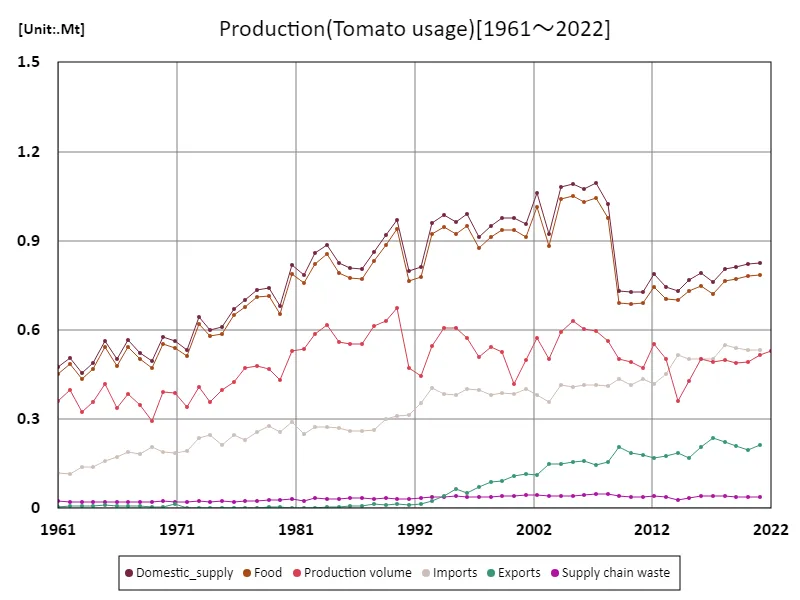

The maximum is 1.09Mt[2007] of Domestic_supply, and the current value is about 75.6%
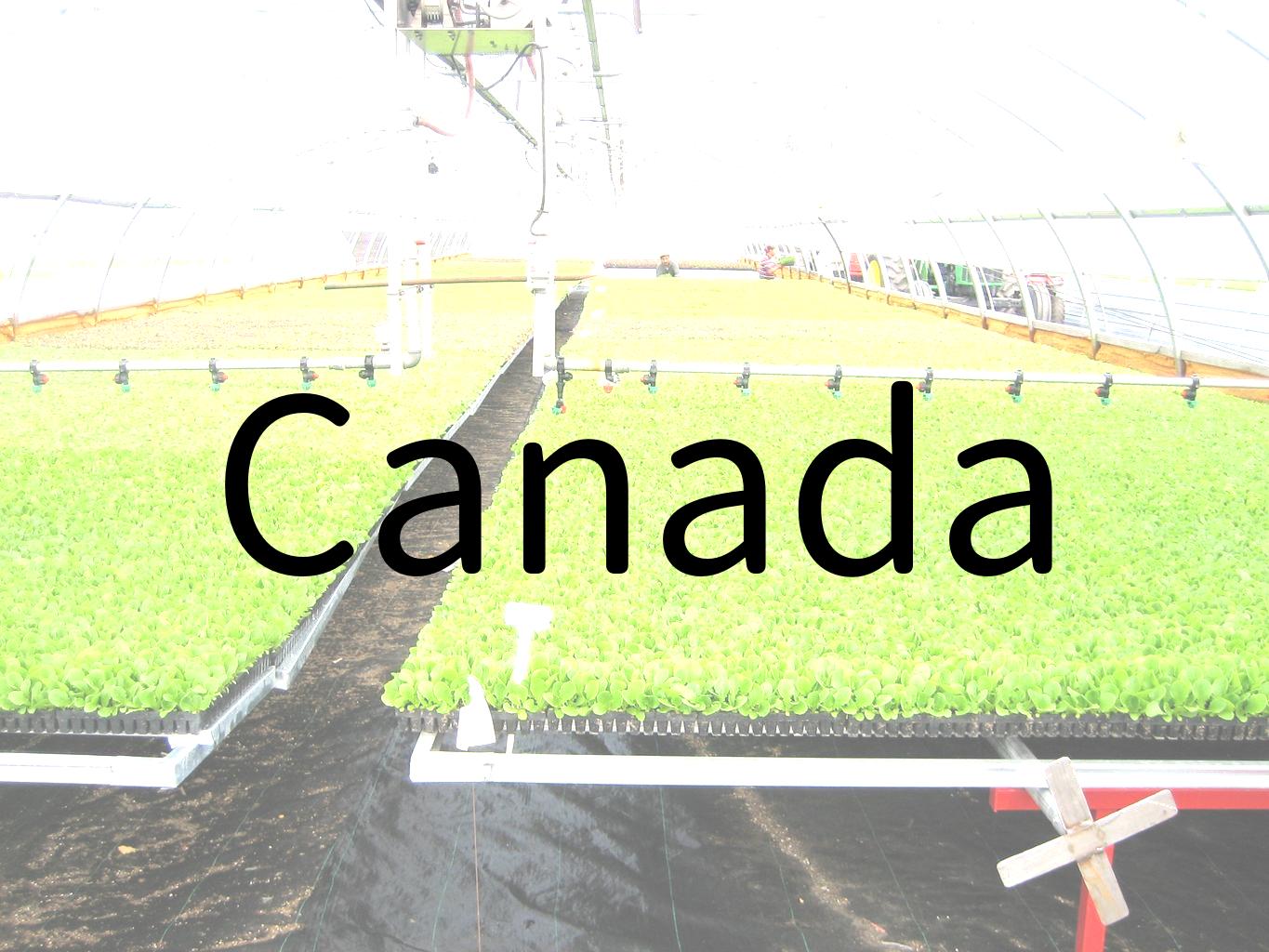


Comments